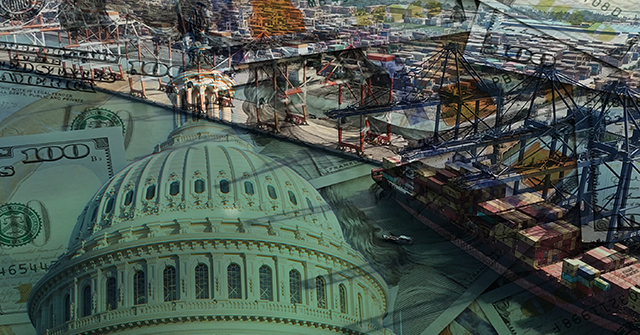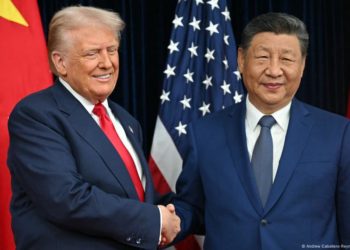Trade Deficits Today, Tomorrow, Forever?
In yesterday’s Breitbart Business Digest, we examined the economists’ brief in Learning Resources v. Trump and its central error: the claim that America’s trade deficits are merely the mirror image of capital inflows—a sign of confidence rather than constraint. We showed that their accounting hides a real-world drain of domestic income offset only by debt. Today we follow that story forward: through the false hope of “intertemporal” balance, the meaning of protectionism, and the question now before the Supreme Court.
The Forever Tomorrow
The economists’ brief gestures toward intertemporal trade theory that nations, like households, may rationally borrow when young to invest in productivity, then save when mature. You accumulate trade deficits today but see surpluses tomorrow.
But the United States has run trade deficits every year since 1971—54 consecutive years. Tomorrow never comes.
Intertemporal theory explains temporary imbalances that reverse over a lifecycle. It cannot justify a permanent structural position as the world’s borrower. At some point, chronic deficits cease to be an investment strategy and become simply the terms of existence.
If the borrowed capital were financing productive investment—infrastructure, education, industrial capacity—the theory might hold. But U.S. infrastructure has deteriorated, educational outcomes have stagnated, and manufacturing capacity has declined relative to our trading partners. The deficits have largely financed consumption and asset appreciation, not productivity growth.
The claim that future gains will allow America to run surpluses and repay its debts is not a theory. It is wishful thinking disguised as economics. Since 1980, the U.S. net international investment position has flipped from a surplus of roughly 10 percent of GDP to a deficit nearing 90 percent, a reversal unmatched by any major economy in history. There are no signs of this unwinding.
Calling this intertemporal trade is like calling a Ponzi scheme a dynamic investment strategy.
If Tomorrow Never Comes
If tomorrow never comes, what follows? The imbalance has endured so long that it has rewritten the nation’s economic metabolism. Our domestic spending no longer maps cleanly onto domestic production. Each year, more of what Americans buy is made abroad, and more of what Americans earn comes from borrowing that replaces the income lost to trade. The system sustains itself not through productivity but through the continual creation of dollar assets.
Our demand drives employment elsewhere, while our liabilities supply the savings outlets that foreign consumers are denied by the industrial policies of their own governments. What began as a post-war strategy has hardened into a structure of dependency.
Much of the confusion about how to respond lies in the word protectionism. Economists use it for any interference with trade, a term of professional reproach. But modern industrial policy aims not to protect firms from competition but to restore the link between national spending and national income.
Encouraging Toyota, Samsung, or Siemens to produce in Kentucky rather than export from abroad does not lessen competition. It changes where the competition occurs. The wages, supply chains, and taxes remain within the U.S. income stream.
Calling this protectionism obscures its purpose. The goal is not retreat from trade but income repair, ensuring that the dollars Americans spend circulate once again through American paychecks. A car built in Kentucky counts as U.S. output even if the parent company is in Tokyo.
Debt as Equilibrium
The economists’ brief celebrates capital inflows as a vote of confidence. In practice, they are the residue of imbalances that the United States has chosen to absorb. Every dollar of foreign investment reflects income that left the U.S. through trade. The world earns dollars by selling to us, then lends them back by buying Treasuries and equities.
They lend those same dollars back not out of confidence but out of necessity. Surplus nations must either hold dollar assets or sell dollars, forcing their currencies to appreciate and lose their export advantage. It’s clear that our trading partners have decided to hold dollars rather than lose manufacturing jobs in their countries. The U.S. Treasury market is not just attractive. It is the only outlet large enough to absorb the world’s excess savings. That is not strength. It is structural entrapment. We are trapped as debtor, they are trapped as creditor.
If you want a libertarian spin on this, this can be looked at as a transfer of spending power from the domestic private sector to the government sector, with foreign producers acting as the middleman. The American worker is made more dependent on the government that owes increasing amounts of debt to foreigners.
This arrangement sustains global demand but transforms America into the system’s balancing wheel. Our deficits are the ballast of others’ surpluses. That is why they persist: the world’s savings model requires them. The equilibrium is maintained not by adjustment but by debt.
A Pattern Across Decades
The pattern has repeated for generations. In the 1980s, Fed Chair Paul Volcker’s interest-rate shock drew in global capital, strengthening the dollar and widening the deficit. President Reagan’s fiscal gap rose to offset lost demand. In the 1990s and 2000s, private credit replaced public borrowing. Asset bubbles masked the drain. When those collapsed in 2008, public debt took their place. Each cycle restored the same equation: external deficits matched by domestic debt.
The 2010s proved the pattern once more. Attempts at fiscal austerity — sequestration, the debt ceiling standoffs — succeeded only in slowing growth. The trade deficit remained. With the government unwilling to borrow enough to offset the external imbalance, the recovery limped along until the COVID shock forced deficit spending to resume.
Economists dismissed the “twin-deficits” theory because they drew the arrows backward. Government borrowing does not cause trade deficits. Trade deficits cause government borrowing by suppressing income.
The Emergency Is Real
The legal issue before the Supreme Court is narrow: may the president use emergency powers to address chronic trade deficits? The economists’ brief argues no, because a deficit is not an “extraordinary threat.” Yet if the imbalance suppresses production, hollows employment, and forces continual borrowing, it plainly is. It’s a slow erosion of sovereignty through dependency.
Recognizing that does not settle the legal questions of whether IEEPA grants this authority, whether the major questions doctrine applies, or whether the remedy is proportional. But it does falsify the economic premise on which the amici rely: that trade deficits are harmless and ordinary. If they suppress income, hollow industrial capacity, and compel chronic borrowing, they are neither. The Court need not endorse tariffs to recognize that the “no threat” assumption is false.
John Maynard Keynes foresaw the danger in 1944 when he proposed an International Clearing Union: surplus nations, no less than deficit nations, must adjust. If only one side bears the burden, he warned, “the process of adjustment is both inequitable and self-defeating.” That is the world we inhabit. Surplus countries preserve employment by exporting demand. Deficit countries preserve employment by importing debt. The result is a permanent transfer of income disguised as stability.
For the United States, this means fiscal deficits are not an aberration but a structural requirement of the order we maintain. Each debt-ceiling standoff is less a dispute over domestic profligacy than over the cost of global balance.
The Real Question
Trade and capital accounts always balance on paper. The books close. The question is who bears the cost. For 54 years, the United States has borne it by borrowing. This is the equilibrium of a world whose surpluses require an American deficit to exist.
The economists’ brief in Learning Resources v. Trump asks the Court to view that imbalance as harmless. In truth, it is the mechanism by which others’ excess production becomes our debt. Before policymakers or judges accept the premise that such deficits are benign, they should first ask the simplest question: How long can a nation spend more than it earns without ever growing poorer?
The economists’ brief offers no answer. Neither does 54 years of evidence.
The post Breitbart Business Digest: The Wealth of Foreign Nations Depends on America’s Endless Budget Deficits appeared first on Breitbart.




